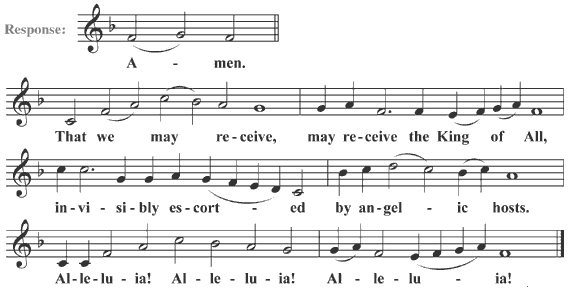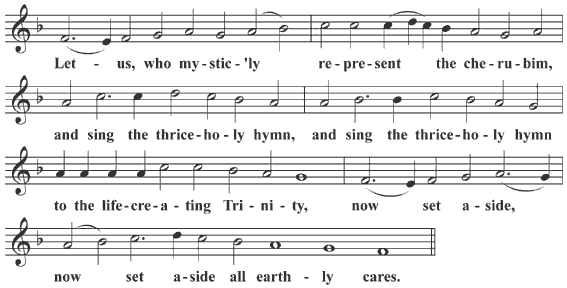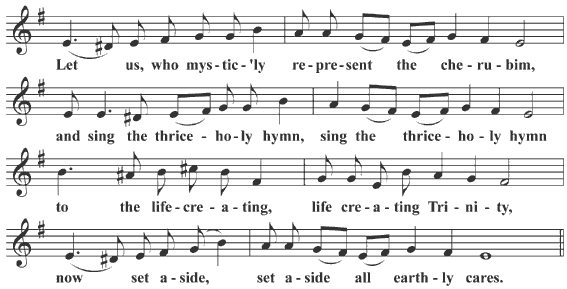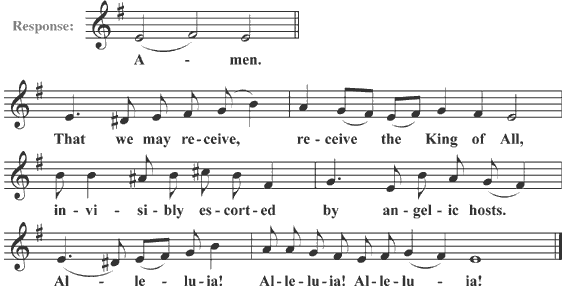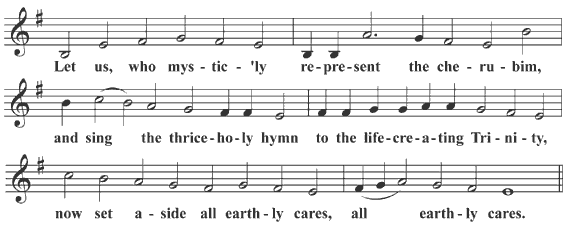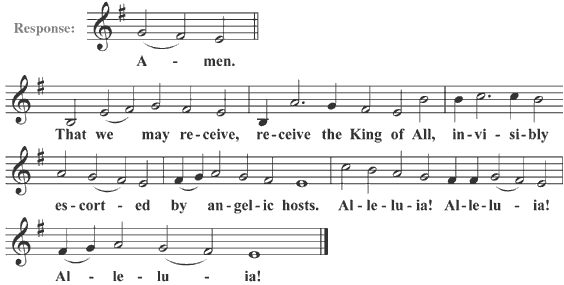Singing the Cherubikon
The Cherubikon or Cherubic Hymn is sung during the Great Entrance procession of the Divine Liturgy, in which the gifts of bread and wine are taken solemnly from the table of preparation to the holy table. This marks the transition from the introductory and catechetical (teaching) part of the Divine Liturgy to the Eucharistic sacrifice itself. This article explains how to sing the Cherubic Hymn, and covers pages 42-49 of our Divine Liturgies book.
The Cherubikon Melodies
The melodies for the Cherubic Hymn are often taken from the folk-song or spiritual song tradition, so that (for example) a song for the Mother of God may have its melody used for the Cherubic Hymn on one of her feast days. As a result, there are more melodies for this hymn than for anything else in the prostopinije repertoire.
The Divine Liturgies book provides nine musical settings for the Cherubic Hymn: six ordinary settings (A-F), one for the faithful departed (G), and two more for particular feasts. The cantor should choose which one is to be sung well in advance of the service, practice it, and be ready to sing it after the Litany of Fervent Supplication (or, if they are included, the Litanies for the Departed and/or the Catechumens and Faithful).
- The first part of the hymn ("Let us who mystically..." through "... all earthly cares.") is ordinarily sung three or four times, to allow time for the priest and deacon to incense the gifts, pray at the altar, and begin the procession.
- The cantor should pace the singing so that one of the repetitions concludes as the procession is making its way through the church. If it is necessary to sing only a portion of the first part of the Cherubic Hymn, that portion should conclude with "now set aside all earthly cares."
- After the deacon and priest chant the commemorations, the faithful sing the second part of the hymn ("That we may receive...") as the clergy enter the sanctuary.
It is customary to sing the following hymns to the same melody as was used for the Cherubic Hymn:
- "We praise you, we bless you" (the hymn at the end of the Anaphora)
- the liturgical Communion Hymn(s)
For a complete table of Communions Hymns and where to find their melodies, see page 56 of the Cantor's Companion.
The Cherubikon A
The A setting of the Cherubikon is based on a paraliturgical hymn for Palm Sunday, Radujsa zilo (Rejoice today). The setting is found on pages 42-43 of the Divine Liturgies book.
Like the Trisagion, the Cherubic Hymn should be sung "straight through", without noticeable gaps or pauses between the phrases. If it is necessary to sing only part of the hymn to properly time the procession, begin the final repetition at "now set aside..."
After the commemorations:
As usual, make sure you can identify the key signature, find the tonic pitch or do, and identify the solfege syllables for the first three or four notes. In this case, both parts of the hymn start on sol. Note that the position of the "Amen" before the second part is not obligatory; if the deacon and priest chant on the tonic pitch from the first part of the hymn, then begin singing the second part of the Cherubikon a perfect fifth above their pitch.
The Cherubikon B
The B setting of the Cherubikon opens in a striking fashion, with a rising perfect fourth followed by a trumpet-like triad (do - mi - so). The setting is found on pages 43-44 of the Divine Liturgies book.
Start this hymn a little low, since rises more than an octave over the initial note. If it is necessary to sing only part of the hymn to properly time the procession, begin the final repetition at "now set aside..."
After the commemorations:
The Cherubikon C
In contrast with the B setting, the C setting of the Cherubikon (DL 44-45) is smooth and flowing.
If it is necessary to sing only part of the hymn to properly time the procession, begin the final repetition at the first "now set aside..."
After the commemorations:
The Cherubikon D
The D setting of the Cherubikon (DL 45-46) opens with a rising perfect fourth, then proceeds in a smooth, flowing fashion with occasional leaps to mi and sol.
If it is necessary to sing only part of the hymn to properly time the procession, begin the final repetition at the first "now set aside..."
After the commemorations:
The Cherubikon E
The E setting of the Cherubikon (DL 46-47) is based on a paraliturgical hymn to the Mother of God, Radujsja Carice, which is also used for a hymn in honor of Saint Nicholas, Otce Nikolaje (O Father Nicholas).
This is one of the shorter settings, and you may need to sing it more times than the others. If you sing it slowly, do not let it drag! If it is necessary to sing only part of the hymn to properly time the procession, you can begin at either "and sing the thrice-holy hymn" or "now set aside."
After the commemorations:
The Cherubikon F
The F setting of the Cherubikon (DL 47-48) is based on another hymn to the Mother of God, Prizri, O Marije (Mary, look upon us). Because of this connection, it is particularly appropriate for feast-days that emphasize the intercessory role of the Theotokos (such as the feast of her Protection, October 1), or for Divine Liturgies for particular needs.
If it is necessary to sing only part of the hymn to properly time the procession, you can begin at either "to the life-creating" or "now set aside."
After the commemorations:
The Cherubikon G
The G setting of the Cherubikon (DL 48-49) is sung at Divine Liturgies for the faithful departed. It should NOT be used on Sundays or feast-days. When sung well, this can be a truly-awe-inspiring version of the Cherubic Hymn.
If it is necessary to sing only part of the hymn to properly time the procession, you can begin at either "and sing the thrice-holy hymn" or "now set aside."
After the commemorations:
Additional settings for particular feasts and seasons
The Cherubikon, "O kto kto"
This setting of the Cherubikon is based on a paraliturgical hymn in honor of Saint Nicholas, O kto kto (O who loves Nicholas the saintly), and can be used both on his feast (December 6) and in the pre-Christmas season, if desired.
If it is necessary to sing only part of the hymn to properly time the procession, begin at the first "to the life-creating."
After the commemorations:
The Cherubikon, "Divnaja novina"
This setting of the Cherubikon (DL 292) is based on a paraliturgical hymn for Christmas, Divnaja novina (Wondrous news to all the earth), and can be used on the feast of the Nativity (December 25) and throughout the post-Christmas season, if desired. (The Divine Liturgies book assumes its use through the feast of Theophany on January 6, but as always, different settings of the Cherubikon can be chosen.)
If it is necessary to sing only part of the hymn to properly time the procession, begin at the first "to the life-creating."
After the commemorations:
After the Great Entrance
Once the Great Entrance and the singing of the Cherubic Hymn is complete, the Divine Liturgy continues with the litany over the Gifts, the kiss of peace, and the Creed or Symbol of Faith. See Singing the Symbol of Faith.






